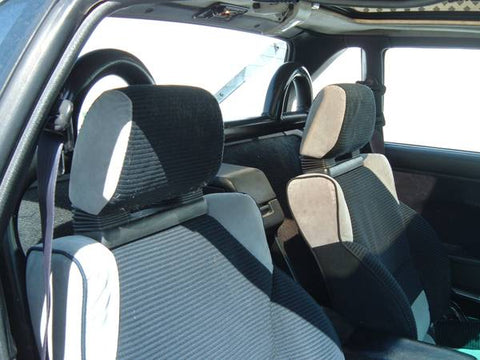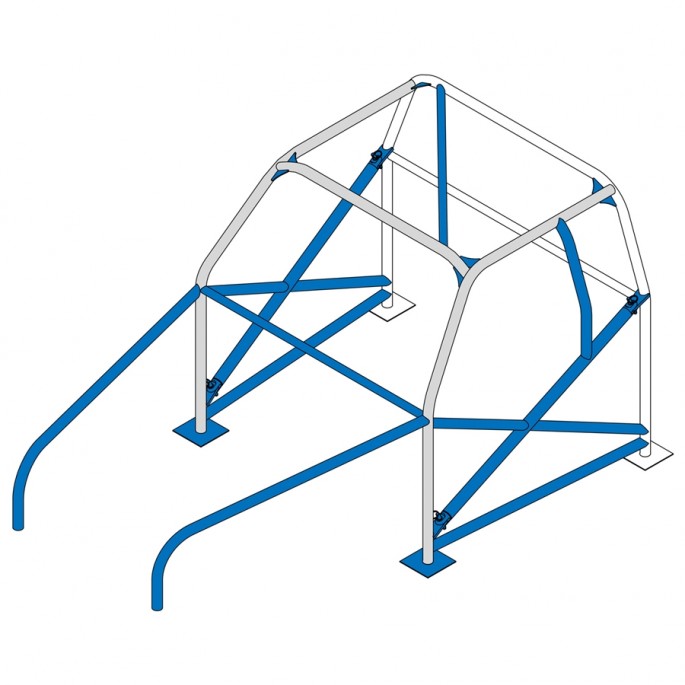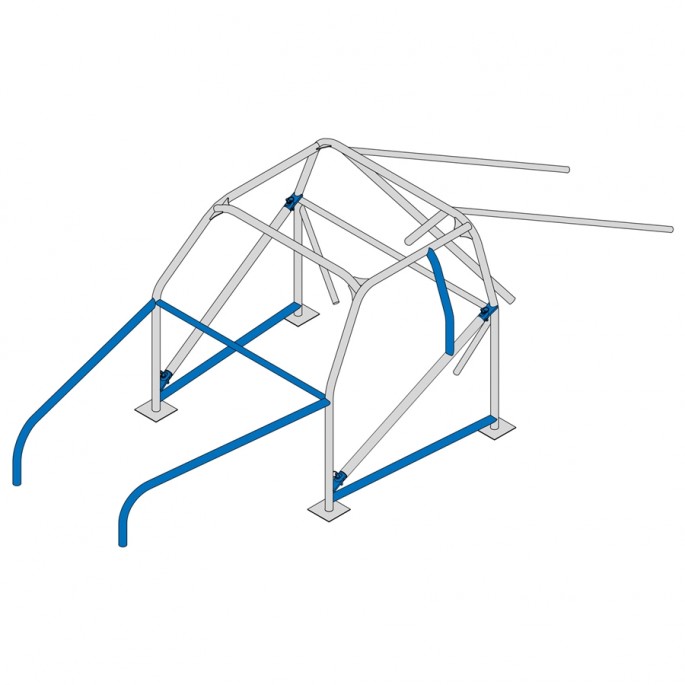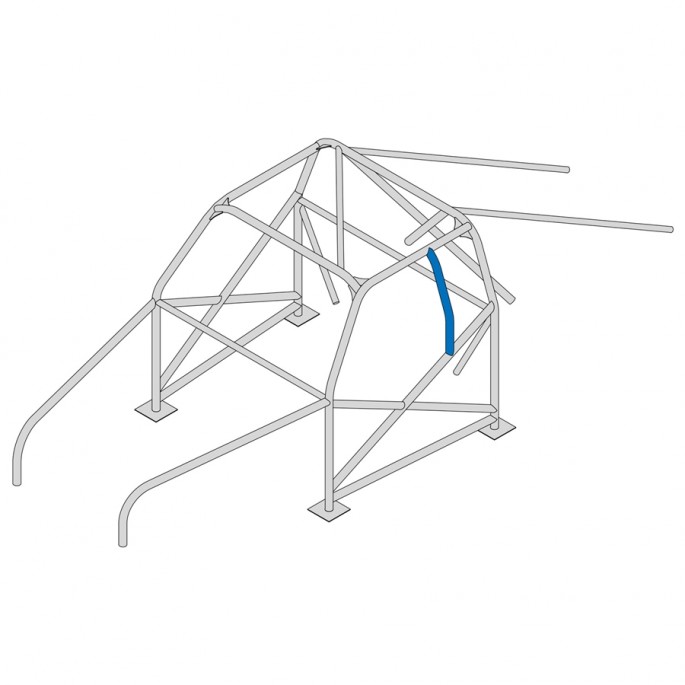
Original article: May 22, 2014 written by:
Nothing is more annoying to me than being at a race or a show and hearing someone refer to their car as “caged up”, only to see that it is in fact sporting a ROLL BAR or some reasonable facsimile thereof. Meanwhile all the guys with actual roll cages in their cars are looking at this poor schmuck as if he has a third eyeball. But do people really not know what the difference is? Does the owner of this MR2 really think that the little hoops behind the driver’s and passenger’s seats are enough to constitute a roll cage? We’re not sure, but thanks to the guys at Chris Alston’s Chassisworks, and their great graphics, we’re going to show you the basics so you aren’t “that guy” anymore.
Generically speaking it’s pretty easy to tell if you are in a car with a roll bar or roll cage simply by thinking about the terms themselves. If you are sitting with a group of tubes that are welded together in such a way as to create a “cage” around you, then it’s pretty safe to say that the car you are in has a roll cage. If the tubes don’t create a cage all the way around you, it’s a roll bar. Both are great, and have their place, but they are two different things.
The drawing below shows a traditional 4-Point Roll Bar, with the 4 “points” being a reference to the number of spots where a tube intersects the floor, or chassis vertically. (Or close to it.) This one happens to include a removable seat belt bar so that you can still access the rear seat, and yet have a seatbelt bar for proper attachment of your 4 or 5 point harness. While this type of roll bar will provide some added rollover protection, it offers less side impact protection than a 6 or 8-Point Roll Bar or Roll Cage. The Roll Bar below does not meet any NHRA standard. While there are exceptions, NHRA ET Rules state that a car can run 11.50 seconds or slower in the 1/4 mile without a Roll Bar.
The drawing below shows an 8-Point Roll Bar. By adding diagonal Door Bars, this type of Roll Bar gives the vehicle a significant increase in rollover protection because the main hoop is supported both front and rear. In addition, it provides increased side impact protection, and a considerable increase in overall structural stiffness for the vehicle it is installed in. You’ll notice that the 8-Point Roll Bar includes two diagonal braces on the inside of the main hoop that tie into the transmission tunnel, 4-link or ladder bar front mounting locations, or front leaf spring hangers. The 8-Point Roll Bar not only creates a safer vehicle when out on the road course, drag strip, or autocross, but also one that will handle much better because the suspension can do it’s job rather than the entire car flexing. Adding a Roll Bar like this to your vehicle will, in most cases, provide a very different driving feel and allow you to maximize your suspension to work at it’s best. The 8-Point Roll Bar below allows you to run much quicker than 11.50 according to NHRA rules. In fact, as long as your vehicle retains the original floor, firewall, etc., the 8-Point Roll Bar below allows you to run as quick as 10.00 seconds in the 1/4 mile.
The drawing below shows several tube options for roll cages. It is missing the rear down tubes in this drawing, and would not be installed like this. Notice the tubes that extend from the main hoop, along the top of the door opening, and down the A-pillar and past the kick panel. Also note the bar across the top of the windshield. These are the basic bars that would be required to convert a Roll Bar to a Roll Cage. The blue bars in the diagram represent options for additional bars in the door and engine compartment areas. Whether or not you need these is dependent on the rules of the sanctioning body that you are racing under, the intended use of the vehicle, and in some instances personal preference.
Now that you understand some of the options and basics, we’ll show you some typical Roll Cages and give examples of when they would be used.
The drawing below shows a Chris Alston’s Chassisworks 12-point Roll Cage. Note that it includes most of the same tubing found in the 8-Point Roll Bar, but ads the previously mentioned bars over the doors, windshield, and out through the firewall. In addition you will notice that this particular cage is equipped with an X setup behind the main hoop that will typically go to one of the suspension crossmembers for added support. This seems like a lot of tubing, but is still designed to be installed inside a stock or fairly stock bodied vehicle. Any car running quicker than 9.99 seconds in the 1/4 mile is required by NHRA to have a Roll Cage. The level of cage required varies based on the ET capabilities of the vehicle, but the 12-Point Roll Cage below would allow a Camaro, Mustang, or other Unibody car to run as quick as 8.50 seconds in the 1/4 mile. If the vehicle this cage was installed in has a full frame that falls outside the drivers legs, the blue bar along the rocker is not required.
The next diagram takes things one step further by adding X bracing in the door area. With this type of setup the swing out door bars found int he previous drawings are not able to be used. This setup is for a vehicle that is designed to spend more time on the track than the street. At least in most people’s minds anyway.
Any car capable of running 9.99 seconds or quicker will require an NHRA Chassis Certification every three years. The NHRA Chassis Certification process is designed to insure that all safety requirements of the chassis, roll cage, and driver’s compartment meet NHRA regulations for the intended ET.
Trust me, there are about a jillion other things we can cover, going over SFI specifications for particular types of chassis, ETs, and classes, but this will wet your whistle, and hopefully keep you from being “that guy” who thinks a Roll Bar is a Roll Cage. Don’t be “that guy”.








Do you men build the bracket for the frame attachment? It is the only approved attachment in the rule book for the Corvette?
I am six feet four inches tall. Can the eight point roll cage be constructed to protect the brain bucket?
Do you men build the bracket for the frame attachment? It is the only approved attachment in the rule book for the Corvette?
I am six feet four inches tall. Can the eight point roll cage be constructed to protect the brain bucket?